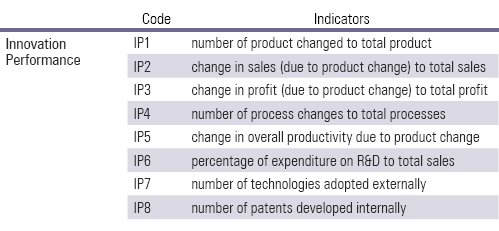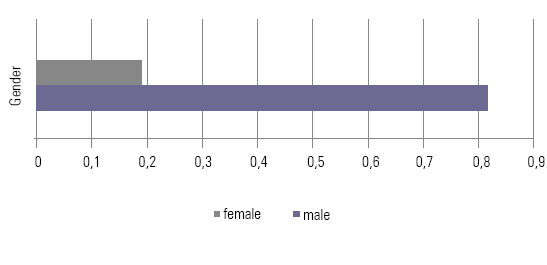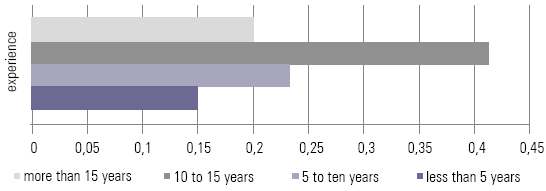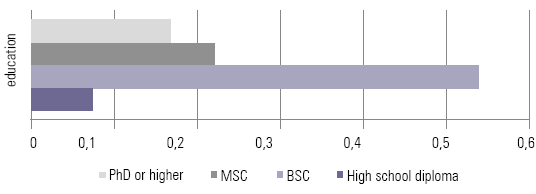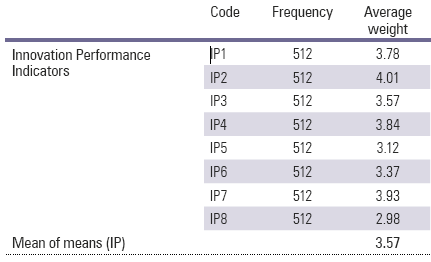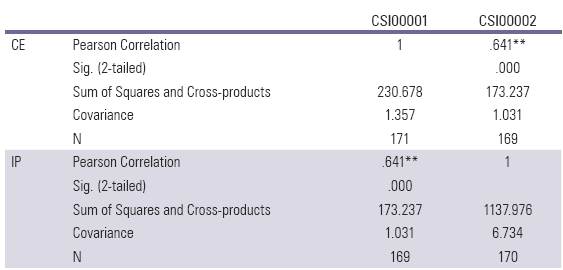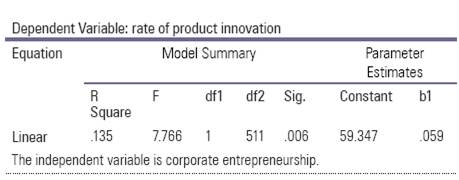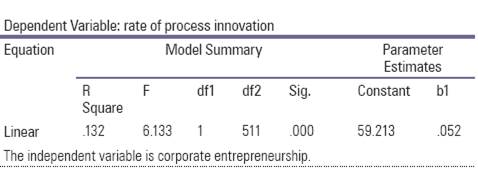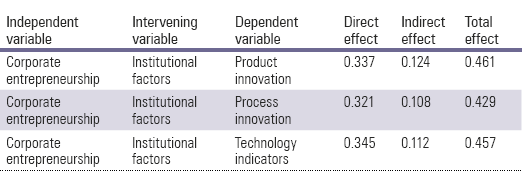INTRODUCTION
Entrepreneurship and business venturing, at both individual and firm levels, are becoming an essential part of any innovation ecosystem (Bharadwaj and Menon, 2000). Today, firms are dynamically striving to become more entrepreneurial and are taking different policies to achieve a better business venturing profile (Morris et al., 2010). Maybe it is due to their understanding that there are a lot of benefits associated with corporate entrepreneurship (Khajeheian and Friedrichsen, 2017). Consequently, we are witnessing that in the last three decades a substantial corporate entrepreneurial wave is shaped (Dunlap-Hinkler et al., 2010). This is more important in established firms than in new ventures, since due to their access to resources and capabilities they are more prone to innovate in their products, services, as well as to improve their technologies (Koen and Bertels, 2015).
On the other hand, innovation performance and entrepreneurial activities of the firms are highly interdependent. However, this argument is not supported in the existing literature clearly (Otache and Mahmood, 2015). Also, there are different approaches in investigating corporate entrepreneurship. This approach has led to a variety of definitions by a variety of authors (Kuratko et al., 2015; Bierwerth et al., 2015). In addition to this, the concepts of media corporate entrepreneurship and media entrepreneurial activities of firms are critical issues which are recently becoming a concern in countries with media entrepreneurship potentials (Miles et al., 2009; Khajeheian and Tadayoni, 2016; Jiang et al., 2018). This is also the case in countries with higher potentials in media sector, and mandates to improve the state of small and medium sized media enterprises in Iran (Khajeheian, 2016, 2018b).
The goal of this paper is to investigate a relationship between corporate entrepreneurship and innovative performance in Iranian media firms. We have developed a research instrument based on Morris and Kuratko (2002), Miller (1983), and Ireland, Kuratko and Morris’s (2006) in order to measure corporate entrepreneurship; and Wong and Chin’s (2007) for measuring innovative performance. Such a relationship is seldom investigated in the media entrepreneurship literature (Gao et al., 2019), which is one of the main theoretical contributions of the present paper. The author focuses on this gap by scrutinizing the interconnectedness and interrelationship between corporate entrepreneurial activities and innovation performance of the Iranian media firms. In order to achieve this goal, the existing literature on the both fields and their connections is reviewed. Then, a framework and its indicators are defined. Findings are presented afterwards, and the paper concludes with some remarks and directions for future studies.
LITERATURE REVIEW
In the present section, the literature about “media entrepreneurship”, “corporate entrepreneurship”, and “innovation performance” are reviewed in more details in order to provide a better understanding of the mentioned research streams.
Media Entrepreneurship:
Although entrepreneurial activities are conducted in media firms, the concept of media entrepreneurship still remains vague and controversial (Khajeheian, 2013, 2017). Despite the great effort made by scholars such as Achtenhagen (2008), Fulton (2015) and Emami and Khajeheian (2019), there are different concepts which come into one’s mind regarding this phenomenon. Moreover, combining corporate entrepreneurial activities with media entrepreneurship in media firms is rarely discussed and scrutinized in the existing literature. Hoag (2008) defines media entrepreneurship as “the creation and ownership of a small enterprise or organization whose activity adds at least one voice or innovation to the media marketplace”. Achtenhagen (2008) put some comments on the mentioned definition and defined media entrepreneurship as “how new ventures aimed at bringing into existence future media goods and services are initially conceived of and subsequently developed, by whom, and with what consequences”. Definitions have evolved and the concept is becoming clearer for the scholars of the field, however, the connection between media entrepreneurship and corporate entrepreneurship is rarely discussed in the literature (Achtenhagen, 2017; Price Schultz & Jones, 2017; Kahjeheian, 2018a). More recently Hang (2016), in his distinguished book, tried to open new windows of opportunity for researchers of the field in order to combine these two concepts. These efforts lead to emergence of the concept of “media corporate entrepreneurship” which is increasingly drawing the attention of scholars.
Corporate Entrepreneurship:
Over the past decades, corporate entrepreneurship has been broadly followed by senior executives and academics as a valuable means for stimulating companies and increasing productivity, effectiveness and affectivity (Zahra and Covin, 1995). This refers to situations where established companies, rather than individuals or business units, act entrepreneurially (Covin and Miles, 1999). Actually, this issue is inevitable important for established firms to survive and renovate their existing status and to increase their profitability and productivity (Zahra, 1996; Kuratko et al., 2014). Corporate entrepreneurship, which entails a complex process due to the challenges regarding the existing structures and processes of the companies, is- in nature- a behavioral phenomenon. Accordingly, all companies are situated in a continuum that ranges from “highly conservative” to “highly entrepreneurial” companies (see, Barringer and Bluedorn, 1999). This is the case, even, for those companies which are rarely attempting to reveal an entrepreneurial representation, but are acting innovatively (Morris et al., 2010).
Corporate entrepreneurship underwent many changes- both in its nature and definition- during its evolution. In a more recent definition of the concept, it is defined as a process through which employees of established firms commence novel activities, follow innovative blueprints, or value departing from usual processes in order to discover, form, or follow profitable entrepreneurial opportunities (see, García-Morales et al., 2014). In fact, entrepreneurship movement involves development of entrepreneurial behaviors within an established firm (Mason, 2011). However, according to some previous definitions of the concept, corporate entrepreneurship is defined as the ability of a company to discover and make use of entrepreneurial opportunities without being repressed by limitations of inputs, policies and regulations, as well as top managerial decisions (Otache and Mahmood, 2015).
As Verma (2013) argues, it encompasses three types of process, i.e. (i) innovation process, (ii) venturing process, and (iii) strategic renewal process. Furthermore, some scholars propose that due to the interactions among different characteristics of individuals and firms, and according to the contextual factors, the nature of corporate entrepreneurial activities might change over the lifecycle of any company (Fini et al., 2012). In a nutshell, since 1980s, many scholars and professionals have shown great interest in the corporate entrepreneurial activities due to its precious effect on the revitalization, productivity and profitability of established firms (Urbano and Turró, 2013). However, some researchers argued that corporate entrepreneurial activities could not realized in large established companies, yet there are a number of advocates for this issue in the literature. Hence, as one could see, in the last decades, “corporate entrepreneurship” research and applications were emerged (Paunović, 2012). While some scholars have provided a basis for explaining and predicting how corporate entrepreneurship goes on in some countries, the author finds it necessary to pay attention to this concept in established firms of a developing economy (e.g. see Analoui et al., 2009; Maatoofi and Tajeddini, 2011). In the present paper, three main models of corporate entrepreneurship, i.e. Morris and Kuratko (2002), Miller (1983), and Ireland et al. (2006) are used in order to reach this aim.
Innovation Performance (IP):
As it is mentioned in the existing literature, results of corporate entrepreneurial activities are shown in two types of issues: (i) strategic renewal of the firms, and (ii) the performance/new venture creation activities (Gómez-Haro et al., 2011; Salamzadeh, 2015; Salamzadeh and Kirby, 2017). Although a company’s approach toward corporate entrepreneurial activities directly affects its innovation performance, one could develop a more comprehensive explanation, based on the fact that this approach might expand the company’s status (Simsek and Heavey, 2011; Salamzadeh and Markovic, 2018). Scholars of this field have conservatively put more stress on ways in which individuals could create positive changes within their own companies (Dunlap-Hinkler et al., 2010). It is important to know that innovation performance is variously defined by several scholars and researchers. For example, it is defined as “the degree to which new products- goods and services- meet their expected goals in the market” (Wang and Lin, 2012), or as “the extent to which new products have attained their share in the market, promoted sales, and increased the rates of asset return, investment return, and respectively met profit goals” (Chen et al., 2014).
In fact, innovation performance which is the outcome of a company’s innovative activities and inputs has been extensively a vital issue for state-of-the-art companies (Wang and Lin, 2012). Moreover, improving innovation performance of the companies is important to an overall understanding of different issues such as learning, creativity, and innovation within companies (Bharadwaj and Menon, 2000). Nevertheless, one should note that innovation performance varies widely across different industrial segments and established organizations (Lee et al., 2015). Optimistically, there are some measures to determine innovation performance and the economic outcomes of innovative products or services (Guan et al., 2009). There are numerous managerial factors which have been linked with innovation performance in innovative companies, according to the existing literature (Wong and Chin, 2007). In order to be more precise, in this paper, Wong and Chin’s (2007) conceptualization of the phenomenon is used, which includes three main groups: (i) Product innovation rate (including: number of changed product/total products, change in sales/total sales; and change in profit/total profit); (ii) Process innovation rate (including: number of process changes/total processes; and change in overall productivity due to product change); (iii) Technology indicators (including: percentage of expenditure on R&D/ total sales; number of externally adopted technologies; and number of internally developed patents) (Wong and Chin, 2007). These categories are defined as follows: Product innovation: without a doubt, product innovation is a vital issue for any established company which competes with its competitors. As new technologies are developed and our knowledge is improved, product innovation turns into a more important concern for established firms that are striving to succeed in this highly competitive world (Chen et al., 2015). Furthermore, nowadays, within established companies which follow corporate entrepreneurial approaches, the importance of new product development is higher, and their employees are usually more prone to follow innovative approaches. Therefore, it is important to gauge product development rates in order to succeed in this competition. On the other hand, the literature suggests that it is a significant part of the most of corporate entrepreneurial approaches (Kuratko et al., 2015; Kuratko and Audretsch, 2013).
Process innovation: process innovation approaches are broadly used in entrepreneurial companies (Kuratko et al., 2014). There are many benefits associated with these approaches. Making radical, substantial, or even gradual improvements in the existing processes in a way those processes become more productive or profitable is the main result of following such an approach in established companies (Alegre and Chiva, 2013). Therefore, process innovation is also a vital subject to be considered in any entrepreneurial established firm (Jayaram et al., 2014). By innovation in processes of a typical established firm, such a company might benefit from new customers, higher customer satisfaction rates, as well as higher returning customers (Adner and Levinthal, 2001).
Technology indicators: Some researchers suppose that innovation performance could be measured by process and product innovation (Hsu et al., 2014), others such as Wong and Chin (2007) and García-Morales et al. (2014) consider technology indicators for such a measurement. Technology indicators include a broad range of factors; however, in order to be more precise, in this study, the author bounded the definition to the above-mentioned indicators (Wong and Chin, 2007).
Innovation system and institutional factors:
Innovation ecosystem is a term which is used in order to describe the large number and diverse nature of participants/resources that are essential for innovation. These entities include entrepreneurs, venture capitalists, researchers, investors, university faculty, as well as business development agents and other technical service providers (Soofi et al., 2018). Each innovation ecosystem is mature to some extent. By the way, several major problems related to the innovation system in Iran, especially in recent decades, are emerging (Mirzadeh et al., 2017). There are a few very large companies, several medium sized firms and a large number of small firms operating in the Iranian innovation ecosystem which deal with each other strongly or loosely (Soofi et al., 2018). The innovation ecosystem is shaped subject to some institutions- rules of the game. Around six thousand new technology based firms have been established in national science parks as well as incubators aftliated to Iran’s Ministry of Science, Research and Technology until now (Salamzadeh and Kawamorita Kesim, 2017). While new technology based firms were struggling with a fact that there was not a recognized and structured ecosystem of innovation in the country, more recently some attempts have been made to clarify this ecosystem, especially by policy makers and oftcials (see, Khajeheian, 2016). One could categorize these elements under the following categories: economic, social, political and technological elements.
For instance, among economic factors, new technology based firms are highly affected by the existence of relevant resources which are scarce in nature, including financial resources, expert human resources, and time limitations (see, Tanha et al., 2011). Regarding social elements, new technology based firms strive to compete with their rivals by absorbing their human resources, internalizing social values, and socializing; at the same time, low social welfare is evident in the ecosystem (see, Mirzadeh et al., 2017). On the other hand, political unrest is vastly evident in the ecosystem, and thus policy makers could do a few things for new technology based firms, such as deregulation. At the same time, political bodies act as facilitators among different players (see, Mirzadeh et al., 2017). Last but not the least, technological elements are of paramount importance, since these elements highly affect the performance of new technology based firms. Especially, technological transitions are very critical (see, Tanha et al., 2011).
RESEARCH METHOD
In this research, a survey is conducted and a questionnaire is employed to collect the required data from the research population of 512 established media firms in seven main provinces of Iran (Tehran, Alborz, Shiraz, Isfahan, North Khorasan, East Azerbaijan, and Semnan) in order to scrutinize the interrelationships of corporate entrepreneurial activities of selected Iranian media firms which is shown in their innovation performance. The conceptual model is developed based on four main models. For CE, 15 items was selected from the questionnaire of Morris and Kuratko (2002), Miller (1983), and Ireland et al. (2006); and for IP, Wong and Chin’s (2007) conceptualization of the phenomenon is used. Tables number 1 and 2 shows the indicators.
SPSS 21.0 was used to analyze the data. To test the strength and type of the relationship among dependent and independent variables, linear regression technique is used. Moreover, regression analysis could be used in order to infer causal relationships among independent and dependent variable(s). By the way, since Likert scale is used, this method will be applicable. It should be noted that institutional elements are also included in the model. Also, the institutional factors are integrated in this analysis to show the contextual effects.
The established media firms were selected randomly from the companies registered in the Company Registration Oftce of Iran under the title of “knowledge based firms”. Under random sampling, each member of the list had an equal opportunity of being chosen as a part of the sampling process. One of the main requirements of random sampling is the fact that it requires a complete list of population, which was hopefully available in this study. According to Cochran’s formula, at the confidence level of 95 percent, and accuracy of 5 percent, 512 questionnaires were required. Thus, the authors distributed 700 questionnaires, and 512 respondents completely filled out the distributed questionnaires (response rate: 73%). The questionnaires were answered by top managers or chief executives of the firms. Questionnaires were printed and distributed by the researcher among the respondents. As mentioned earlier, the questionnaire of this research was adapted from those of Morris and Kuratko (2002), Miller (1983), and Ireland, Kuratko and Morris (2006), Wong and Chin (2007).
Following a pilot test- among 45 established firms, the instrument was modified and refined by three experts before it was used (Expert validity/ Face validity). The reliability of the instruments was analyzed by Cronbach’s alpha coeftcient (0.758). Hence, the administered questionnaire had enough reliability to proceed for further analysis. Based on the research goals, the following hypotheses are highlighted to be studied.
H 1 . The rate of product innovation of Iranian media firm is related to the level of corporate entrepreneurial activities in those firms.
H 2 . The rate of process innovation of Iranian media firm is related to the level of corporate entrepreneurial activities in those firms.
H 3 . The level of technology indicators of Iranian media firm is related to the level of corporate entrepreneurial activities in those firms.
Table 1 Indicators of corporate entrepreneurship
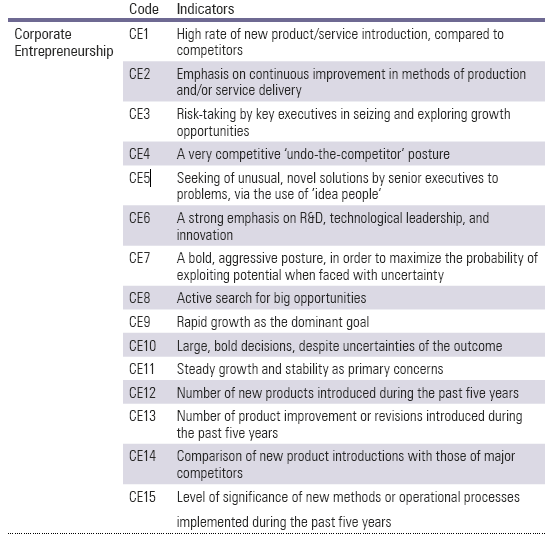
Source: Morris and Kuratko (2002), Miller (1983), and Ireland, Kuratko and Morris (2006)
FINDINGS
Demographic information:
Most of the respondents were male (81%), while a few of them were female (19%) (Chart 1). Moreover, about one third of the respondents had 10 to 15 years of experience (41%) (Chart 2), and most of them had a bachelor’s degree (54%) (Chart 3). Chart 4 illustrates the demographic information of the firms. As shown in the chart, most of the firms had between 50 to 100 employees and might considered as small businesses. In terms of the experience of the firms, those that have 5-10 years of experience constitute the highest. Most of the firms were in Production field, and the rest were service providers. Most of the firms had 5 to 10 new products/services.
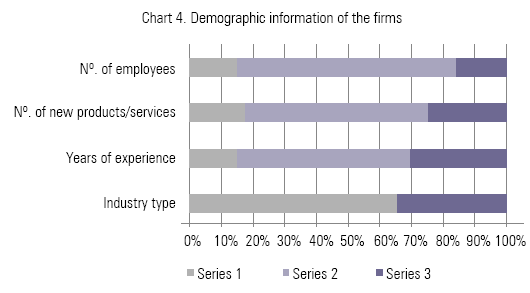
Legend: Industry type: Series 1: Production; Series 2: Service provider II Years of experience: Series 1: 3 to 5 years; Series 2: 5 to 10 years; Series 3: more than 10 years II Number of new services/products: Series 1: Less than 5; Series 2: 5 to 10; Series 3: more than 10 II Number of employees: Series 1: Less than 50; Series 2: 50 to 100; Series 3: more than 100
Chart 4 Demographic information of the firms
State of corporate entrepreneurship and innovation performance indexes:
It is important to understand the existing state of studied firms in terms of corporate entrepreneurship (Morris and Kuratko, 2002, Miller, 1983, and Ireland, Kuratko and Morris, 2006) and innovation performance indexes (Wong and Chin, 2007); since it might highlight some important points, such as their weaknesses and strengths. Tables number 3 and 4 shows the mean indexed of corporate entrepreneurship and innovation performance indexes in the studied firms. Means of means shows that firms are somehow conservative and corporate entrepreneurship policies are moderately followed in these companies (Table 3). According to the three mentioned theories which led to this model (i.e. Morris and Kuratko, 2002, Miller, 1983, and Ireland, Kuratko and Morris, 2006), some propositions might be offered. First of all, high rate of new product/service introduction, compared to competitors is moderately evident as the companies strived to compete vigorously (CE1). Second, a very competitive ‘undo-the-competitor’ posture is evident in the findings (CE4). Moreover, number of new products/services introduced during the past five years in the studied companies were high (CE12). Finally, it could be noticed that the level of significance of new methods or operational processes implemented during the past five years was high (CE15). At the same time, emphasis on continuous improvement in methods of production and/or service delivery (CE2), seeking of unusual, novel solutions by senior executives to problems, via the use of ‘idea people’ (CE5), and steady growth and stability as primary concerns (CE11) were low. It might be due to deficiencies in delivery system, lack of innovativeness in senior managers, as well as several institutional concerns that might hamper the growth of the studied companies. According to the data gathered based on Wong and Chin’s (2007) model regarding innovation performance indexes, it is evident that the number of product changed to total product (IP1) as well as change in sales (due to product change) to total sales were high (IP2). Moreover, the number of process changes to total processes (IP4) were high, and number of technologies adopted externally (IP7) were increasing. Innovation performance index shows a moderate level of innovation performance in the firms (Table 4).
Correlation analysis:
Before testing the hypotheses, we have to make sure that there is a significant correlation between corporate entrepreneurship and innovation performance (Product innovation, Process innovation, and Technology indicators). To do so, a correlation analysis was conducted. The following tables show that there is a significant correlation among these two concepts.
Hypotheses testing:
Hypotheses are tested accordingly and results are discussed in the below section. Regression analysis generated an equation to describe the statistical relationship between predictor variables and the response variable. After defining the regression model in SPSS, the fit was verified by checking the residual plots, and the results were interpreted.
H 1 . The rate of product innovation of Iranian media firm is related to the level of corporate entrepreneurial activities in those firms.
A linear regression was performed. As can be seen, corporate entrepreneurship was a significant predictor of rate of product innovation. According to the table, product innovation rate is significantly dependent on corporate entrepreneurship in the studied established firms. Therefore, the more innovative products are produced by the established firms, the more they would be considered corporate entrepreneurial firms (Kuratko et al., 2015). As Artz et al. (2010) previously mentioned rate of product innovation could significantly affect corporate entrepreneurial performance of the firms, while Zhang (2011) believed that product innovation was not found to be significantly effective on corporate entrepreneurship performance. The findings are in line with the first group of scholars; however, one might propose different hypotheses to examine the probable differences in these findings. The regression equation is as follows:
Rate of product innovation = 59.347 + 0.059 * corporate entrepreneurship, R2 = .135,
F (1, 511) = 7.766, p < .006.
H 2 . The rate of process innovation of Iranian media firm is related to the level of corporate entrepreneurial activities in those firms.
As it is mentioned in the table, corporate entrepreneurship was a significant predictor of rate of process innovation. Based on the table, rat of process innovation is also significantly affected by corporate entrepreneurial activities. This finding is in line with some scholars such as Kuratko et al. (2015), however, to some scholars, process innovation is not significantly affected by corporate entrepreneurial activities (e.g. see Bigliardi et al., 2011). It might be due to the differences in range of studies, which is highly affected by firm size and industry type (Damanpour, 2010). In this study, most of the firms had less than a hundred employees and might considered as small businesses. The regression equation is as follows:
Rate of process innovation = 59.213 + 0.052 * corporate entrepreneurship, R2 = .132,
F (1, 511) = 6.133, p < .000.
H 3 . The level of technology indicators of Iranian media firm is related to the level of corporate entrepreneurial activities in those firms.
As it is mentioned in the table, corporate entrepreneurship was a significant predictor of technology indicators. Table 9 shows a significant relationship between technology indicators and corporate entrepreneurship. Based on the test results, technology indicators could be affected by corporate entrepreneurial firms. It means that if these firms become more entrepreneurial, technology indicators might change significantly. This element is infrequently discussed in the literature, and the findings of this research approve such relationship. In sum, all the hypotheses were accepted according to the results. It shows that corporate entrepreneurship affects innovation performance of the firms. The interesting point is that, although a considerable number of the firms were risk averse in nature, still the relationship exists. The regression equation is as follows:
Technology indicators = 60.125 + 0.052 * corporate entrepreneurship, R2 = .120, F (1, 511) = 7.723, p < .002.
The effect of institutional factors- as intervening variables- is also studied. Thus, the results are shown in the following table. The findings are the result of a report of the (standardized) direct, indirect, and total effects, all of which can be obtained from the path coeftcients. According to the findings, the institutional factors affect the relationship between corporate entrepreneurship and innovation performance (Product innovation, Process innovation, and Technology indicators).
CONCLUSION
Media corporate entrepreneurship activities are becoming an integral part of any established media business which thrives to succeed (Hang & Van Weezel, 2007). Despite the fact that the concept is an emerging phenomenon, less attention has been paid to this issue in the existing literature. Even, the existing studies have marginally paid attention to this phenomenon (e.g. see Hang, 2016). It should be noted that innovation performance of the firms is also dependent on such activities (Otache and Mahmood, 2015). Thus, this study tried to shed more light on this relationship by studying 512 established Iranian media firms in seven provinces. The three studied hypotheses are tested and accepted based on the findings. Moreover, findings showed that there is a significant relationship between corporate entrepreneurship and the rate of product innovation, rate of process innovation and the technology indicators of the established Iranian media firms. These are in line with the findings of Barringer and Bluedorn (1999), Bharadwaj and Menon (2000), García-Morales et al. (2014), Chen et al. (2014), Hang (2016), and Khajeheian and Salamzadeh, 2013; and in contrast to those of scholars such as Zhao (2005) and Goodale et al. (2011).
Future researchers might focus on industry level innovation performance to see if regions with higher rate of corporate entrepreneurship enjoy higher innovation performance or not. Such efforts would be studied in the field of media firms, as these companies have a broad range of audience who follow them. Thus, researchers might focus on its impact on socio-economic development of the regions. Moreover, media corporate entrepreneurship might be operationalized using other frameworks (e.g. see Zahra, 1996; García-Morales et al., 2014; Kuratko et al., 2014). Using other types of questionnaires might improve the generalizability of the findings. Also, it is suggested that, in future studies, authors pay more attention to institutional factors using North’s (1971, 1986) definition of formal and informal institutional factors. Consequently, it is suggested for future scholars to use other operational definitions as well.
By the way, policy makers might improve media corporate entrepreneurship ecosystem in order to enhance innovation performance of the established media firms, and to improve the socio-economic state of the regions. Managers could also give attention to media corporate entrepreneurial activities in order to make their organization more innovative, and to get more audience and to expand their business. There were some limitations as well in conducting this research. For instance, there was no scale for measuring media corporate entrepreneurship, and thus one of the most commonly used models was used in this research. Moreover, data gathering was time consuming and findings the experts were also a difficult task. By the way, most of the respondents were not completely aware of the concept of media corporate entrepreneurship; however, they have already been involved in such activities.













